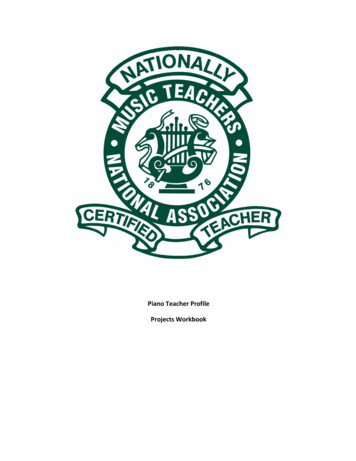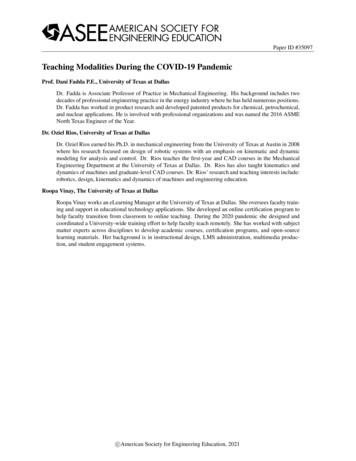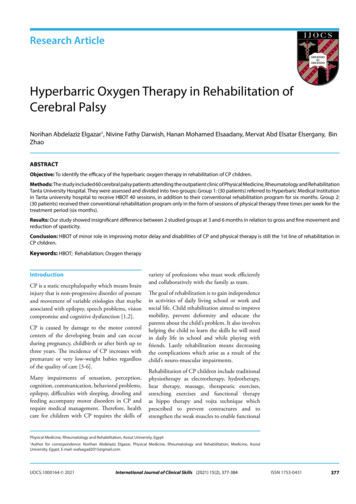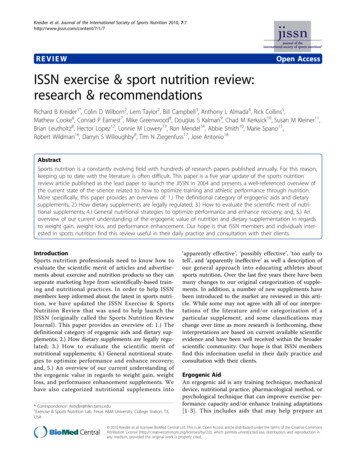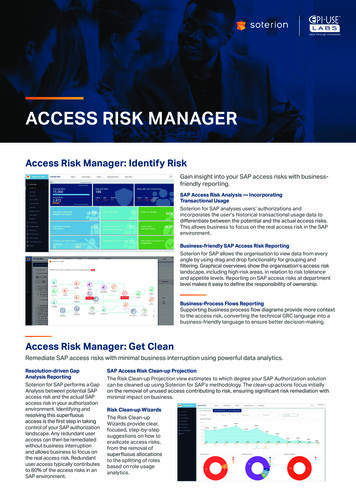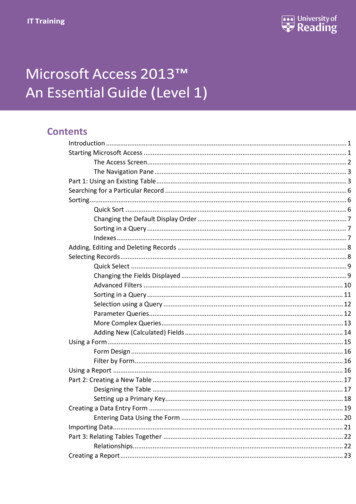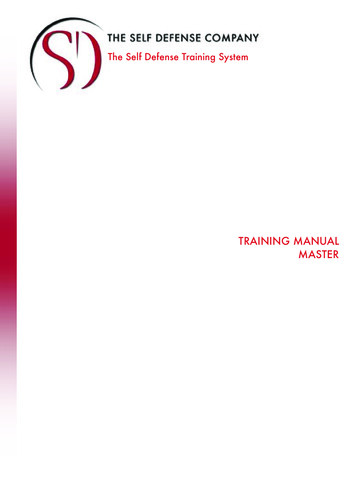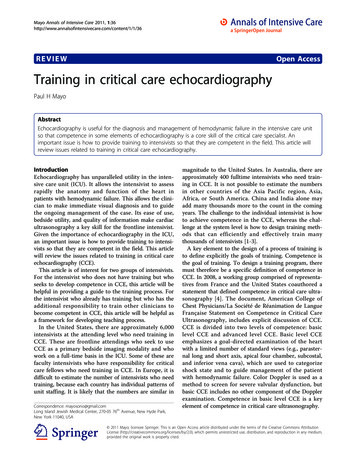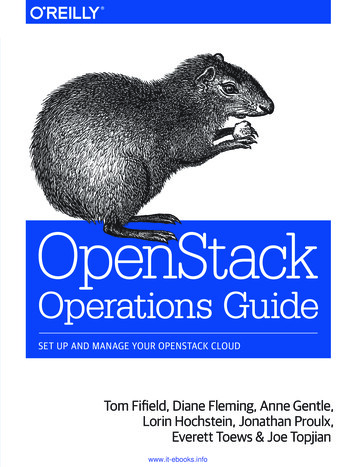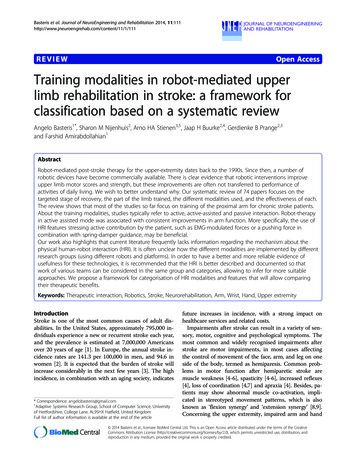
Transcription
Basteris et al. Journal of NeuroEngineering and Rehabilitation 2014, 11REVIEWJNERJOURNAL OF NEUROENGINEERINGAND REHABILITATIONOpen AccessTraining modalities in robot-mediated upperlimb rehabilitation in stroke: a framework forclassification based on a systematic reviewAngelo Basteris1*, Sharon M Nijenhuis2, Arno HA Stienen3,5, Jaap H Buurke2,4, Gerdienke B Prange2,3and Farshid Amirabdollahian1AbstractRobot-mediated post-stroke therapy for the upper-extremity dates back to the 1990s. Since then, a number ofrobotic devices have become commercially available. There is clear evidence that robotic interventions improveupper limb motor scores and strength, but these improvements are often not transferred to performance ofactivities of daily living. We wish to better understand why. Our systematic review of 74 papers focuses on thetargeted stage of recovery, the part of the limb trained, the different modalities used, and the effectiveness of each.The review shows that most of the studies so far focus on training of the proximal arm for chronic stroke patients.About the training modalities, studies typically refer to active, active-assisted and passive interaction. Robot-therapyin active assisted mode was associated with consistent improvements in arm function. More specifically, the use ofHRI features stressing active contribution by the patient, such as EMG-modulated forces or a pushing force incombination with spring-damper guidance, may be beneficial.Our work also highlights that current literature frequently lacks information regarding the mechanism about thephysical human-robot interaction (HRI). It is often unclear how the different modalities are implemented by differentresearch groups (using different robots and platforms). In order to have a better and more reliable evidence ofusefulness for these technologies, it is recommended that the HRI is better described and documented so thatwork of various teams can be considered in the same group and categories, allowing to infer for more suitableapproaches. We propose a framework for categorisation of HRI modalities and features that will allow comparingtheir therapeutic benefits.Keywords: Therapeutic interaction, Robotics, Stroke, Neurorehabilitation, Arm, Wrist, Hand, Upper extremityIntroductionStroke is one of the most common causes of adult disabilities. In the United States, approximately 795,000 individuals experience a new or recurrent stroke each year,and the prevalence is estimated at 7,000,000 Americansover 20 years of age [1]. In Europe, the annual stroke incidence rates are 141.3 per 100,000 in men, and 94.6 inwomen [2]. It is expected that the burden of stroke willincrease considerably in the next few years [3]. The highincidence, in combination with an aging society, indicates* Correspondence: angelobasteris@gmail.com1Adaptive Systems Research Group, School of Computer Science, Universityof Hertfordshire, College Lane, AL95HX Hatfield, United KingdomFull list of author information is available at the end of the articlefuture increases in incidence, with a strong impact onhealthcare services and related costs.Impairments after stroke can result in a variety of sensory, motor, cognitive and psychological symptoms. Themost common and widely recognised impairments afterstroke are motor impairments, in most cases affectingthe control of movement of the face, arm, and leg on oneside of the body, termed as hemiparesis. Common problems in motor function after hemiparetic stroke aremuscle weakness [4-6], spasticity [4-6], increased reflexes[4], loss of coordination [4,7] and apraxia [4]. Besides, patients may show abnormal muscle co-activation, implicated in stereotyped movement patterns, which is alsoknown as ‘flexion synergy’ and ‘extension synergy’ [8,9].Concerning the upper extremity, impaired arm and hand 2014 Basteris et al.; licensee BioMed Central Ltd. This is an Open Access article distributed under the terms of the CreativeCommons Attribution License (http://creativecommons.org/licenses/by/2.0), which permits unrestricted use, distribution, andreproduction in any medium, provided the original work is properly credited.
Basteris et al. Journal of NeuroEngineering and Rehabilitation 2014, 11function contributes considerably to limitations in theability to perform activities of daily living (ADL). One ofthe goals of post stroke rehabilitation is to regain arm andhand function, since this is essential to perform activitiesof daily living independently.Page 2 of 15aspects that stimulate restoration of arm function [20-23].These important aspects of rehabilitation training involvefunctional exercises, with high intensity, and with activecontribution of the patient in a motivating environment.Rehabilitation roboticsStroke rehabilitationStroke rehabilitation is often described as a process ofactive motor relearning that starts within the first fewdays after stroke. Recovery is characterized by a highinter-individual variability, and it occurs in differentprocesses. Some of the first events following nervoussystem injury are recovery due to restitution of noninfarcted penumbral areas, reduction of oedema aroundthe lesion, and resolution of diaschisis [10-12], and comprise spontaneous neurological recovery. A longer termmechanism involved in neurological recovery is neuroplasticity, caused by anatomical and functional reorganisation of the central nervous system. Additionally, motorrecovery after stroke may occur through compensationalstrategies. Compensation is defined as behavioural substitution, which means that alternative behavioural strategiesare adopted to complete a task. In other words, functionwill be achieved through alternative processes, instead ofusing processes of ‘true recovery’ alone [11-13].Treatment approachesMany treatment approaches have been developed to aidmotor recovery after stroke. These interventions aredifferent in their approach to achieve functional gains.For instance, in the 1950s and 1960s, the so-called neurofacilitation approaches were developed. From theseapproaches based on neurophysiological knowledge andtheories, the Bobath Concept, or neurodevelopmentaltreatment (NDT), is the most used approach in Europe[14-16]. This approach focuses on normalizing muscletone and movement patterns, guided by a therapist usingspecific treatment techniques, in order to improve recovery of the hemiparetic side. Gradually, focus shifted towards the motor learning, or relearning approach [17].Others have referred to these methods as the taskoriented approach. These new methods of clinical practiceare based on the notion that active practice of contextspecific motor tasks with suitable feedback will supportlearning and motor recovery [11,17].Overall, there is a lack of convincing evidence to support that any physiotherapy approach is more effectivein recovery than any other approach [15,16,18]. However, in a review of Langhorne et al. [19], it is stated thatsome treatments do show promise for improving motorfunction, particularly those that focus on high-intensityand repetitive task-specific practice. Moreover, researchinto motor relearning and cortical reorganisation afterstroke has showed a neurophysiologic basis for importantRobot-mediated therapy for the upper limb of strokesurvivors dates back to the 1990s. Since then a numberof robotic devices have become commercially availableto clinics and hospitals, for example the InMotion ArmRobot (Interactive Motion Technologies Inc., USA, alsoknown as MIT-Manus) and the Armeo Power (Hocoma,Switzerland). Robotic devices can provide high-intensity,repetitive, task-specific, interactive training. Typically,such robots deliver forces to the paretic limb of the subject while practicing multi-joint gross movements of thearm. Most of the robotic devices applied in clinical trialsor clinical practice offer the possibility of choosing amongfour modalities for training: active, active-assisted, passiveand resistive. These terms relate to conventional therapymodes used in clinical practice and refer to subject’s statusduring interaction. Passive training for example refersto subject-passive/robot-active training such as in continuous passive motion (CPM) devices. The choice ofmodality ( ies) in each protocol is ultimately made byresearchers/therapists.There is evidence that robotic interventions improveupper limb motor scores and strength [24-26], but theseimprovements are often not transferred to performanceof activities of daily living (ADL). These findings areshared among the most recent studies, including the largest randomised controlled trial related to robot-therapyto date [27]. A possible reason for a limited transfer ofmotor gains to ADL is that the earlier studies on robotmediated therapy have only focused on the proximaljoints of the arm, while integration of distal with proximal arm training has been recognized as essential to enhance functional gains [28,29].Another issue involved in the limited transfer of motorgains to ADL improvements in robot-mediated therapyresearch may relate to the large variety of devices andprotocols applied across clinical trials. Lumping togethermany devices and protocols does not provide knowledgeof the effectiveness of individual components, such aswhich of the available therapeutic modalities result in thelargest effect [25]. Consequently, in literature there hasbeen a transition towards reviews focusing on selective aspects of robot-mediated therapy, rather than its overall effectiveness [30-33].A major step in that direction is the description of different control and interaction strategies for robotic movement training. In a non-systematic review, Marshal-Crespoet al. [34] collected a set of over 100 studies involvingboth upper and lower limb rehabilitation. They made a
Basteris et al. Journal of NeuroEngineering and Rehabilitation 2014, 11first distinction between assistive, challenging and hapticsimulating control strategies. They also described assistiveimpedance-based controllers, counterbalancing, EMGbased and performance-adapted assistance. Furthermore,they highlighted the need for trials comparing differentinteraction modalities. However, that review only includedarticles up to the year 2008 while much more new information has become available in the recent years.Loureiro et al. [35] described 16 end-effector and 12exoskeleton therapy systems in terms of joints involved,degrees of freedom and movements performed [35]. However, this non-systematic review did not report about theeffects of the interventions or identify the interaction orcontrol strategies used. Specifically focusing on training ofthe hand, Balasubramanian et al. [36] identified 30 devicesfor hand function and described them in terms of degreesof freedom, movements allowed, range of motion, maximum force (torque) and instrumentation. Among thesedevices, eight showed an improvement in functional useof the affected hand, in terms of increased scores on theAction Research Arm Test, Box and Block test or WolfMotor Function Test [36]. Understanding and specificallytargeting mechanisms underlying recovery of the entireupper limb after stroke is essential to maximize improvements on function or even activity level.This literature study works towards clarifying thedefinitions adopted in robotic control and interactionstrategies for the hemiparetic upper extremity (includingboth proximal and distal arm segments), and identifyingthe most promising approaches. The objective of this systematic review is to explore and identify the human robotinteraction mechanisms used by different studies, basedon the information provided in literature. We propose aframework to support future categorisation of variousmodalities of human-robot interaction and identify anumber of features related to how such strategies are implemented. In addition, we will compare clinical outcomein terms of arm function and activity improvements associated with those interactions, which allows us to identifythe most promising types of human robot interactions.MethodsWe conducted a systematic literature search on PubMedwith keywords including stroke, robot and arm, upperlimb, shoulder, elbow, wrist or hand. Detailed information about the search strategy is provided in Additionalfile 1: Appendix 1. We included full journal papers writtenin English about robotic training of (any part of) the upperlimb. These included either uncontrolled (pre-post design)or (randomised) controlled trials, in which a group of atleast four subjects received robot-mediated training. Inaddition, training outcome must be statistically evaluated(either pre- or post-treatment for the single group or a difference between groups). In cases where results from thePage 3 of 15same subjects were presented (partially) in other studies(e.g. a pilot study and the definitive protocol) we retainedthe study with the largest number of participants or themost recent study, if the number of participants were thesame. Also, we discarded those studies where other interventions were applied during robot-mediated exercise (e.g.functional electrical stimulation). Two independent reviewers (AB and SN) conducted the search and selectedthe appropriate articles by discarding those articles whichdid not meet the selection criteria, based on title first, abstract second and subsequently using full-text articles. Incase of doubt, the article was included in the next roundof selection. After full-text selection, the two reviewerscompared their selections for consensus. For each article,only those groups of subjects that were treated with arobotic device were included. Since some studies compared several experimental groups that differed by subjecttype, device used or experimental protocol, the number ofgroups did not match the number of articles. Thus, werefer to number of groups rather than number of studies.For each group we filled a record in a structured table.Since the outcome of an intervention can be influencedby many factors, such as the initial level of impairmentor the frequency and duration of the intervention, thistable contains an extensive set of information (presentedin Additional file 2): device used; arm segments involvedin training; time post-stroke; number of subjects per group;session duration; number of weeks training; number of sessions per week; total therapy duration; modality ( ies) andfeatures of HRI; baseline impairment measured as averageFugl-Meyer score; and clinical outcome in terms of bodyfunctions and activity level. Arm segments involved werecategorised as one (single arm segment) or more (multiplearm segments) of shoulder, elbow, forearm, wrist and hand,in which forearm represents pro/supination movement atthe radio-ulnar joint. Time since stroke was categorised according to Péter et al. [37], considering the acute phase asless than three months post stroke, the sub-acute phaseas three to six months post stroke and the chronic phaseas more than six months post stroke.The main focus of this work is on the interactionbetween the subject and the robot. Table 1 categorises different ways of intervention commonly found in existingrobot-mediated therapy (termed as ‘training modalities’ inthis work). In active mode, performance arises from subjectcontribution only, whereas in passive mode the movementis performed by the robot regardless of subject’s response.In assistive modality, both subject and robot contributionaffect movement performance. Passive-mirrored mode applies to bimanual devices, when the movement of the affected side is guided based on active performance of theunimpaired side. In active-assisted mode, the subject isperforming actively at the beginning of the movement andthe robot intervenes only when given conditions are met
Basteris et al. Journal of NeuroEngineering and Rehabilitation 2014, 11Page 4 of 15Table 1 Training modalities in robot-mediated therapyModalitySpecificationsAssistiveSubject’s voluntary activity is required during the entire movement. Robots canassist either providing weight support or providing forces aiming at task completion.ActiveThe robot is being used as a measurement device, without providing force tosubject’s limb.PassiveRobot performs the movement without any account of subject’s activity.Passive-mirroredThis is for bimanual robots, when the unimpaired limb is used to control the passivemovement of the affected side.Active-assistiveAssistance towards task completion is supplied only when the subject has not beenable to perform actively. At this stage, the subject experiences passive movementof the limb.CorrectiveSubject is stopped by the robot when errors (e.g. distance from a desired position)overcome a predefined value and then asked to perform actively again.Path guidanceRobot guides the subject when deviating from pre-defined trajectory.ResistiveRobot provides force opposing the movement.(e.g. if the target has not been reached within a certaintime), leading to systematic success. In corrective mode instead, in such a case the robot would stop the subject to letthen reprise active movement. In path guidance mode, thesubject is performing actively in the movement direction,and the robot intervention is limited to its orthogonaldirection. Finally, in resistive mode, the robot makes themovement more difficult by resisting the movement received from the subject. We categorised each group according to these modalities. Note that some terms referto the subject status (i.e. “passive” and “active”), othersto the robot behaviour (e.g. “resistive”).However, these categories are not specific enough toclassify such different interventions. For example, in thecase of reaching movements, the assistive modality wouldSchemarefer to both cases where the robot is providing weightsupport or applying target-oriented forces. The termscommonly describing modalities of robot-mediated therapy (such as passive, active-assisted, resistive) had to berevised to provide more specific definitions in order toproceed with unambiguous classification. We thereforecategorised all the modalities in a different way, specifically based on the features of their implementation. To doso, we identified the following specific technical featuresused to implement a certain modality (termed ‘HRI features’ in this work): passive, passive-mirrored, movingattractor, assistive constant force, triggered assistance,pushing force (in case of delay), EMG-proportional, tunnels, spring-damper guidance, spring and damper againstmovement. These categories are defined in detail in
Basteris et al. Journal of NeuroEngineering and Rehabilitation 2014, 11Table 2. Note that neither training modalities nor featuresof HRI are mutually exclusive categories, since groupsmight have been tested with several training modalities,and each modality might involve the presence of morethan one HRI feature. We propose the classification oftraining modalities and HRI features adopted in this workas a framework for classification for future studies. This isan open framework, so that as new modalities or featuresare developed and tested, specific categories could beadded, to be further referred.We related clinical outcome to factors as segments ofthe arm trained, time since stroke and modalities and HRIfeatures. We assessed clinical outcome as whether reported improvements were statistically significant or not,for each measure. Outcome was considered separately forbody functions and structures (e.g., Fugl-Meyer, ModifiedAshworth Scale, kinematics) and activities (e.g., ActionResearch Arm Test, Wolf Motor Function Test, MotorActivity Log), according to ICF definitions [38]. We categorized each outcome measure to either body functions oractivities as defined by Sivan et al. [39] and Salter et al.[40-42]. A group was considered to have shown improvement when at least two-thirds of all the outcome measures within a specific category (of either body functionsor activity level) had improved significantly.ResultsIn September 2013, our search led to a total of 423 publications. The first two rounds of filtering, based on titlePage 5 of 15and abstract, led to a set of 126 articles. After screeningfull-text articles, 74 studies were included, with a total of100 groups treated with robots. Of the 74 studies, 35were randomised controlled trials and 39 were clinicaltrials (pre-post measurement), involving 36 different devices. Group sizes ranged from 5 to 116 subjects, with atotal of 1456 subjects. Table 3 presents a summarisedoverview of all included studies, grouped by device. Detailed information for each group is given in the table inAdditional file 2: Appendix 2.With respect to stages of stroke recovery (Figure 1a),73 of the 100 groups included patients in the chronicstage, 17 involved patients in the acute stage, and fourgroups involved patients in the sub-acute stage. In sixcases subjects at different stages of recovery were included in the same group or no information about timesince stroke was provided. The average FM score at inclusion among groups of acute subjects was 17.7 12.7and 25.9 9.5 among chronic subjects. The higher average score for subacute subjects (29.3 7.8) is possibly anoutlier due to the small number of observations.When considering the arm segments (Figure 1b), weobserved that training involved shoulder movementsfor 71 groups, elbow flexion-extension for 74 groups,wrist movements for 32 groups, forearm pronationsupination for 20 groups, and hand movements for 20groups. Training rarely focused on a single part of thearm, with four groups specifically trained for elbow[86,90,92,93], five groups for wrist [73,85,87,88] and sixTable 2 Features of modalities of human robot interaction and their implementation in robot-mediated therapyFeatureSpecificationPassive, passive-mirroredThe device is programmed to follow a desired trajectory/force profile with a strong attractor (up to 1000 N/m)towards it.In the case of passive mirrored, the desired input is given by the subject with the unimpaired hand.In some cases, these trajectories can be set by the therapist during a “learning” phase.Moving attractorIn such a case the assistance is lower than in passive control, the robot is still attracted towards a minimum jerkor smooth trajectory but the amount of assistance can be modulated by varying the stiffness that attracts therobot to the trajectory.Triggered assistanceThe subject initiates a movement without assistance. The robot observes that the on-going performance if thetask is not completed (e.g. time expired) and intervenes taking the full control, as in the passive mode.Assistive constant forceForce oriented towards the target or weight support when movement is against gravity.EMG-proportionalThe power of the EMG signal is used to control the actuators.Pushing force (in caseof delay)A force aligned with the movement direction assists the subject only if there is a delay in comparison with ascheduled motion pattern.Spring-damper guidanceElastic or visco-elastic force fields aim at reducing the lateral displacement from a desired trajectory.TunnelsThese can be displaced within the virtual environment to produce a haptic feedback only if error overcomesa (large) threshold value. A tunnel can be seen like a lateral spring-damper system plus a dead band zonewhich makes the haptic intervention discrete in time. This particular cueing of errors relates to a corrective strategy.Spring against movementThe device opposes movements through an elastic force-field pulling back to the start position.Damper against movementThe device generates a force opposing the movement based on current velocity. Although this increases theeffort of the subject, it also stabilizes the movement by damping oscillations.Not clearThe information in the text (or its references) did not allow classifying the article. As an instance, if the only mentionto the physical interaction was “the robot assisted the subjects during the task”, this was considered not clear dueto not providing details on the method of assistance.
Basteris et al. Journal of NeuroEngineering and Rehabilitation 2014, 11Page 6 of 15Table 3 Overview of included studies: characteristicsDeviceArmsegmentPhase# ofReferences # of subjects Training duration in Traininggroups(total)hours [mean (SD)]modalitiesHRI featureMIT-MANUS (InMotion2)S, EAcute6[43-48]13224.2 (10.9)P, As, AA,PGSDG, NC, P, PF, TAChronic20[48-59]39422.3 (17.0)As, AA, R, Ac SDG, MA, NC, PF, S,TAMIT-MANUS (InMotion2)S, E, F, W,HChronic3[27,49]6424.0 (10.4)As, AASDG, PFMIT-MANUS(InMotion2 3)S, E, F, WChronic3[59-61]6336.0 (0)As, AA, AcSDG, NC, PFBi-Manu-TrackF, WAcute2[62,63]5310.0 (0)P, PM, RP, PM, SChronic5[64-67]4826.8 (12.9)P, PM, R, AcNC, P, PM, SMIMES, EAcute2[68]3612.2 (5.1)P, PM, AA, R NC, P, PM,SSubacute 3[69]2415.0 (0)P, PM, AA, R SDG, P, PM, TA, DChronic4[70-72]3724.0 (0)P, PM, AA,PG, RSDG, P, PM, TA, D1 DoF robotic deviceWChronic1[73]820.0 (0)P, AA, AP, TA2 DoF robotic deviceS, EChronic1[73]1220.0 (0)P, AA, AP, TA3 DoF wrist roboticexoskeletonF, WChronic1[74]910.0 (0)As, Co, AcMA,D5DoF industrial robotS, E, WAcute1[75]821.4 (0)P, AA, AcPAmadeoHAcute2[76,77]149.2 (5.9)P, AAP, NCChronic1[78]1218.0 (0)AANC, PMixed2[79]1515.0 (0)P, As, AcNC, PACT3DS, ESubacute 2[80]14UnknownAs, RACFARM-GuideS, EChronic[81]1018.0 (0)AAPF, TA1AMESW, HChronic1[82]565.0 (0)PPBFIAMTS, EChronic1[83]2012.0 (0)PM, C, RMA, PM, TWCyberglove, Cybergrasp Haptic MasterS, E, W, HChronic1[84]1222.0 (0)AAACFCYBEX, NORMWChronic1[85]Unknown(27 in total)UnknownPPPolyJbotWChronic1[85]Unknown(27 in total)UnknownAAEMGEMG-driven systemEChronic1[86]730.0 (0)AAEMGWChronic2[87,88]1542.0 (0)As, AA, REMG, SHChronic1[89]1020.0 (0)As, AcEMGAJBEChronic1[90]618.0 (0)AAEMGHand mentor robotsystemW, HMixed1[91]1030.0 (0)P, AA, AcP, TAMyoelectricallycontrolledrobotic systemEChronic2[92,93]1416.0 (5.7)As, AA, REMG, SGentle/SS, EMixed2[94]319.0 (6.4)P, AA, Co,AcNC, PHaptic KnobF, W, HChronic1[95]1318.0 (0)P, AA, RMA, PHWARDW, HChronic3[96,97]3622.8 (0.6)AA, AcP, TABraccio di FerroS, EChronic1[98]1011.3 (0)P, AA, Co, R, CF, T,DAc
Basteris et al. Journal of NeuroEngineering and Rehabilitation 2014, 11Page 7 of 15Table 3 Overview of included studies: characteristics (Continued)MEMOSMEMOS, Braccio di FerroS, ES, EAcute1[99]916.0 (0)P, AA, AcP, TA,Chronic3[99-101]4916.0 (0)P, AA, AcP, TASubacute 1[102]2015.0 (0)AA, AcTAChronic[102]2115.0 (0)AA, AcTA1REHAROBS, EMixed1[103]1510.0 (0)PPNeReBotS, E, FAcute2[104,105]2818.3 (2.4)P, AsP, PFREO Therapy SystemS, EAcute1[106]1011.3 (0)P, AsNC, PReoGo SystemS, EChronic1[107]1915.0 (0)As, AA, PG,AcNCT-WREXS, E, W, HChronic2[108,109]1921.0 (4.2)As, AcACFPneu-WREXS, E, HChronic1[110]1324.0 (0)As, AA, AcACF, NCVRROOM, PHANTOM,WREXS, EChronic1[111]2612.0 (0)UL-EX07S, E, F, WChronic2[112]1018.0 (0)PM, AsPM, MA, SDG,ACFBrightArmS, E, W, HChronic1[113]512.0 (0)AsACF, NCLinear shoulder robotSChronic1[114]18UnknownAs, AATA,ACFL-ExosS, E, FChronic1[115]918.0 (0)As, PGMA, ACFAbbreviations:Upper extremity segment: S Shoulder E Elbow F Forearm W Wrist H HandHuman Robot Interactions (HRI): P Passive PM Passive-Mirrored S Spring against movement MA Moving attractor TA Triggered assistance PF Pushing force (in case of delay) EMG EMG-proportional T Tunnels SDG Spring-damper guidance ACF Assistive constant force D Damper against movement NC Not Cleargroups for hand [76-79,116] movements. Training ofmovements involving the entire upper limb (as thoseperformed during ADL) is not highly recurrent (sevengroups) [27,49,84,108,109,113].We then considered the modalities used, and Figure 2shows an overview of the frequency of usage of eachmodality. In 63 groups more than one modality was used.Training included active-assistive modality in 63 groups.Twenty-eight groups were trained in assistive modality.Passive training was included in 35 groups. Active and resistive modalities were involved less frequently, in 29 and22 groups, respectively. The passive-mirrored modalitywas used in 14 groups, path guidance in seven groups andcorrective strategy in five groups.We also considered these frequencies with respect tothe stage of recovery. Passive and passive-mirrored modality are more recurrent for acute than for chronicsubjects (with 77 and 24% of the groups of acute trainedwith these modalities, versus the respective 21 and 11%of chronic subjects). Similarly, modalities more suitablefor less impaired subjects as resistive and active aremore recurrent among chronic (23 and 30% of the cases,respectively) than within acute subjects (18% for bothmodalities). Instead, the choice among modalities wasnot affected by the level of impairment (as measured byFM score). As an instance, subjects trained with passivemodality had an average FM of 27.1 12.8 at inclusionversus 23.9 9.6 of those who did not receive this treatment. Subsequently, we considered the HRI features. In26 groups there was no clear description or reference tothe intervention. Passive and passive mirrored modalitiesshowed the same frequency as reported for the previousclassification (35 and 14 groups) as the definition ofthese categories coincides in the two classifications.
Basteris et al. Journal of NeuroEngineering and Rehabilitation 2014, 11Page 8 of 15Arm segmentsStage of istMixedHandFull arma)b)Figure 1 Fraction of groups classified by time since stroke (a) and by segments of the arm trained (b).Triggered assistance, spring-damper along move
limb rehabilitation in stroke: a framework for classification based on a systematic review Angelo Basteris1*, Sharon M Nijenhuis2, Arno HA Stienen3,5, Jaap H Buurke2,4, Gerdienke B Prange2,3 and Farshid Amirabdollahian1 Abstract Robot-mediated post-stroke therapy for the upper-e
